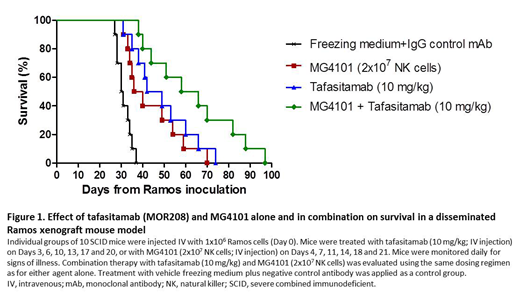Introduction
Tafasitamab (MOR208) is an Fc-enhanced, humanized, monoclonal antibody that binds to the human B cell surface antigen CD19. CD19 is broadly and homogeneously expressed across different B cell malignancies, including diffuse large B cell lymphoma (DLBCL), and amplifies B cell receptor signaling and induces tumor cell proliferation. Tafasitamab is currently in clinical development in patients with relapsed or refractory DLBCL in combination with the immunomodulatory drug lenalidomide (L-MIND study) and the chemotherapeutic agent bendamustine (B-MIND study). The modes of action of tafasitamab comprise antibody-dependent cellular cytotoxicity (ADCC), antibody-dependent cellular phagocytosis (ADCP) and direct cytotoxicity (apoptosis). Tafasitamab carries two amino acid exchanges in the Fc region to increase its affinity to Fcγ receptors, including FcγRIIIa. FcγRIIIa plays a key role in mediating ADCC and is expressed on the surface of natural killer (NK) cells, as well as the majority of γδ T cells.
MG4101 (a novel therapeutic agent consisting of cryopreserved, ex vivo-expanded, highly activated NK cells) has demonstrated potent anticancer activity in preclinical in vitro and in vivo studies. Currently, MG4101 is in clinical development in patients with malignant lymphoma and advanced solid tumors.
Here, we have characterized two FcγRIIIa receptor-expressing cell types, γδ T cells and NK cells (MG4101), as effector cells for tafasitamab in vitro and explored the concept of supplementing MG4101 during tafasitamab therapy using disseminated in vivo models of non-Hodgkin's lymphoma.
Methods
γδ T cells (CD3+/γδ T cell receptor+) were derived from different donors by stimulation of peripheral blood mononuclear cells with zoledronate/IL-2 for 9-10 days. These were applied as effector cells in in vitro ADCC assays with tafasitamab in Mino and Jeko-1 mantle cell lymphoma (MCL) cell lines, as well as primary patient-derived chronic lymphocytic lymphoma (CLL) and MCL cells. Further, effector cell activity of MG4101 was assessed using tafasitamab-mediated ADCC assays in Raji and Ramos Burkitt's lymphoma cells. The concept of combining tafasitamab with allogeneic effector cell therapy in vivo was studied in two therapeutic survival models of disseminated lymphoma in SCID mice. In the Raji model, tafasitamab (0.05 µg/mouse) was given on Day 1 after intravenous (IV) tumor inoculation, while MG4101 (2x107 cells/mouse) was given on Days 1, 3, 6, 8 and 10. In the Ramos model, tafasitamab (10 mg/kg) and MG4101 (2x107 cells/mouse) were applied twice weekly for 3 weeks starting on Days 3 and 4, respectively, after IV tumor inoculation.
Results
Tafasitamab in combination with γδ T cells showed distinctly increased ADCC in Mino and Jeko-1 target cells in vitro, compared with a negative control IgG1 antibody. ADCC assays with patient-derived CLL and MCL target cells confirmed tafasitamab-mediated cytotoxic activity and demonstrated a clear enhancement in activity compared with the non-Fc-enhanced version of tafasitamab that was unable to induce substantial cytotoxicity. In vitro ADCC assays with tafasitamab and MG4101 on Raji and Ramos cell lines confirmed potent effector cell activity of the ex vivo-expanded, cryopreserved, allogeneic NK cells.
In the disseminated Raji survival model, combination therapy with a single low dose of tafasitamab (0.05 µg) and MG4101 resulted in a distinct increase in survival of the mice with an increased life span (ILS) of 100% compared with monotherapy (ILS of 57% for tafasitamab and 50% for MG4101). Of note, the combination demonstrated a substantial and more than additive enhancement in survival in the more therapeutic Ramos survival model (Figure 1). Combination therapy with tafasitamab (10 mg/kg) and MG4101 NK cells resulted in superior antitumor activity (ILS of 103%) compared with either tafasitamab monotherapy (ILS of 49%) or MG4101 alone (ILS of 25%).
Conclusions
FcγRIIIa-expressing immune cell types, including NK cells and γδ T cells, are potent effector cells for tafasitamab-mediated ADCC. Combination therapy with tafasitamab and allogeneic MG4101 NK cells in vivo demonstrated a more than additive survival benefit compared with tafasitamab or MG4101 monotherapy in a disseminated therapeutic lymphoma model. Combination of tafasitamab supplemented with immune effector cells could represent a promising new approach for lymphoma therapy.
Her:GC LabCell: Employment, Patents & Royalties. Cho:GC LabCell: Employment, Patents & Royalties. Hwang:GC LabCell: Employment, Equity Ownership, Patents & Royalties. Boxhammer:MorphoSys AG: Employment, Patents & Royalties. Steidl:MorphoSys AG: Employment. Patra:MorphoSys AG: Employment. Schanzer:MorphoSys AG: Employment. Endell:MorphoSys AG: Employment, Patents & Royalties.
Author notes
Asterisk with author names denotes non-ASH members.


This feature is available to Subscribers Only
Sign In or Create an Account Close Modal